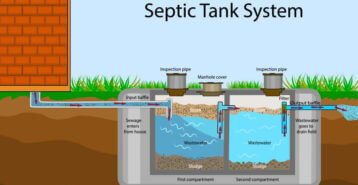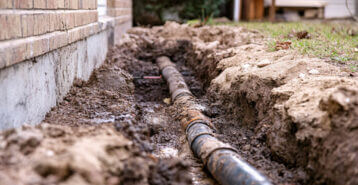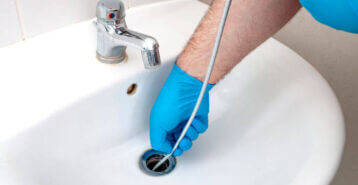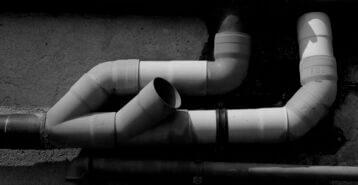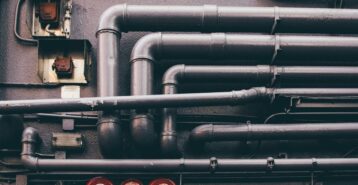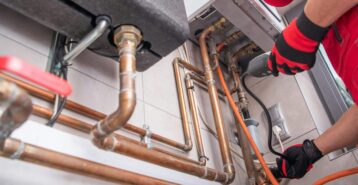Drain Repair or Replacement: Cost & What to Expect
Replacing a drain line, or drain repair in general, is often a sudden and unexpected expense. The drain line, or drain pipe, is the pipe that takes wastewater away from your home. When you run the dishwasher, wash clothes in the washer, use the shower, or otherwise perform any action that leads to water being diverted out of the home after use, a drain line is what makes that magical disappearance happen.
Drain lines carry wastewater from sinks, tubs, and toilets inside your home, while sewer lines transport that waste from your home to the main sewer or septic system. When a drain line is clogged or broken, it begins to wreak havoc almost immediately. That’s when you call a plumber to get the inspection and verdict on what went wrong and what needs to happen to fix it. Understanding the cost to repair or replace a drain line can help you prepare for the expense of keeping the water flowing properly.
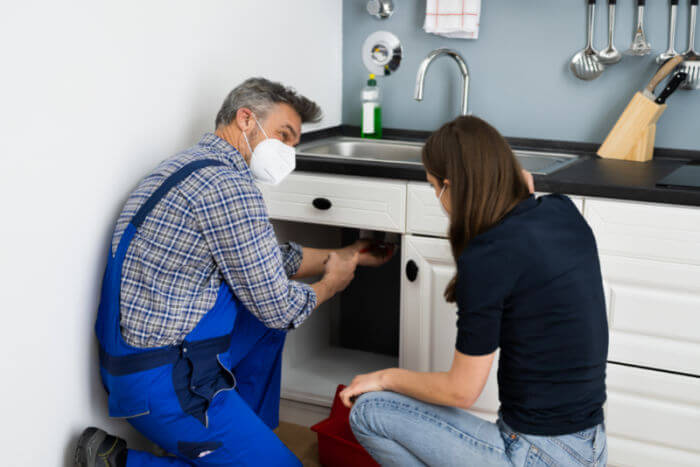
What Can Lead to Drain Line Repair?
There are some clear signs that you have a problem with your drains. These include:
- Slow Drainage: This is usually the first sign that there is something wrong with the drains. In many cases, you can clear a clog yourself, but if the obstruction continues or gets worse again after a few days, you might have something more serious lurking in the pipes.
- Waste or Water Backing Up: If the problem is bad enough that water is backing up into your home instead of going out to the sewer lines where it should, it’s time to call an emergency plumber. This is especially true if you wind up with a sewage backup in your home; that’s a dangerous health issue that must be corrected right away.
- Bad Odors Coming Out of the Drains: What’s that smell? Often a terrible smell from the drains indicates a serious problem, especially if it comes along with slow drainage or water backing up. Once it’s this bad, the odds of it going away are miniscule. It’s time for professional help.
- Gurgling and Strange Sounds: Strange sounds from your drains can indicate that air is getting into the pipe, that there is a clog that keeps moving, or that you have a more serious issue, such as tree roots infiltrating the pipes. A little sound now and then is normal, but when it becomes more frequent than not, it’s time to call for help.
How Much Does Drain Repair Cost?
It can be difficult to pin down how much a drain repair will cost because there are so many factors that can play into the problem. The cost will depend upon the type of pipe, where the problem is located, and the materials and labor costs.
On average, drain repair will cost between $250 and $1,250 for replacing or repairing drainpipes. Keep in mind that this is based on a small section of pipe that is easy to access. If you must replace or repair pipes that are under the ground or under your home, you’re looking at a much higher price. Replacing the entire system can run between $15,000 and $20,000.
Some problems are quite common and as such, the price is easier to pin down. Here are a few.
- Minor Cracks or Leaks: Repairing the pipe and stopping the leak will run between $150 and $850, depending upon how bad the leak or crack is and where it’s located.
- Localized Blockages: Clearing a simple blockage can often be done on your own; however, if a plumber must do it, expect them to charge by the hour. The national average rates are between $50 and $200 per hour.
- Tub/Shower Drain Replacement: The average cost to replace a tub or shower drain is around $700 but can range from $500 to $1,200.
- Root Intrusions: Getting rid of the roots and fixing the pipe can mean bringing in some heavy equipment. Expect to pay between $450 and $2,500 for this — higher if your pipe is very old and severely damaged.
- Toilet Drain Clogs: Severe clogs might lead to problems that are impossible to clear yourself. Fortunately, most toilet drain repair is straightforward. Expect to pay between $100 and $350.
- Main Line Leaks: These leaks are often underground or underneath your house, where simply getting to the pipe can be the bulk of the labor cost. Depending upon where it is, the problem can cost between $450 and $2,500 to repair.
- Sewer Backup: A problem with your sewer main line is among the most expensive fixes, costing between $2,000 and $4,000, on average. This is often an emergency situation, as sewage backup into the home is a serious health threat that must be handled immediately.
Drain Repair Costs Based on Material
There are many different types of pipes, all of which come with different price points. Here is the average cost to repair different materials.
| Pipe Material | Cost per Linear Foot |
|---|---|
| PVC | $0.50 to $8 |
| Polypropylene | $1 to $15 |
| Copper | $2 to $15 |
| Galvanized | $3 to $8 |
| Cast Iron | $10 to $30 |
Let’s break down those costs:
- PVC: This material is quite common for wastewater drains. They are quite easy to work with, which makes it easier for the plumber to do the work, which in turn leads to lower labor costs. However, they can break under high pressure — especially when subjected to freeze-thaw cycles — so don’t expect the same longevity as you get with other pipe materials.
- Polypropylene: This lightweight material is also easy to work with, offer durability on a par with PVC, and doesn’t take long to install. It’s also unlikely to release harmful chemicals into the water, so you don’t have to worry about using this for your intake pipes as well as your drains.
- Copper: Copper has a high resistance to corrosion, which means they will last as long, if not longer, than cast iron pipes will. There’s no iron in copper pipes, which means they won’t corrode. However, if your water has a high acid level, the copper pipes can deteriorate on the inside and eventually lead to leaks and mold buildup.
- Galvanized: These are common in older homes. These pipes are covered in zinc, which is meant to withstand corrosion; however, as the zinc wears away, the galvanized pipes will quickly rust. Rust can easily equal cracks and breaks in the pipe, necessitating replacement.
- Cast Iron: Most older homes have cast iron drain lines, which can last up to 70 years with proper maintenance. But when they do break, it usually results in a serious problem that requires full replacement to fix — and considering that cast iron is the most expensive option for drainpipes, you’re looking at a significant blow to your bottom line.
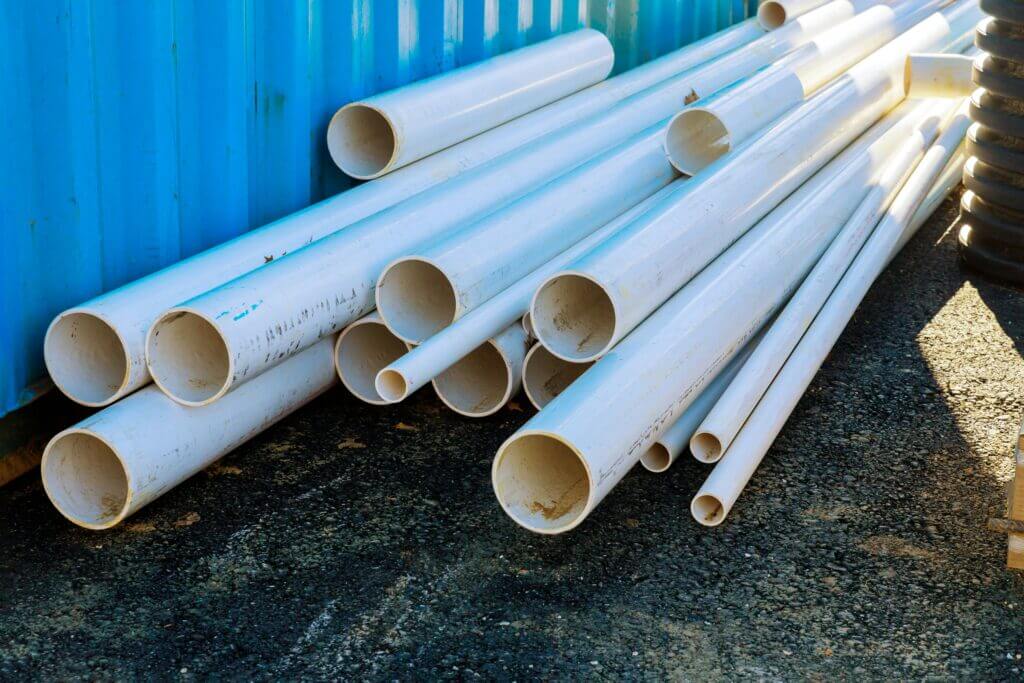
How Much Does Drain Replacement Cost?
When do you know a drain repair won’t fix your problem, and the drain must be replaced instead? Here are a few red flags that will tell you when those pipes have reached the end of their useful life.
- Extensive Damage. If your plumber drops a camera into the pipe and finds one crack after another, the damage is pretty serious. That will require full replacement.
- Old and Worn Pipes. If your pipes are reaching the end of their expected lifespan, it shouldn’t be a surprise when they stop working properly. Remember that cast iron can last up to 70 years, but galvanized or even copper won’t last nearly that long.
- Frequent Repairs. If you find that you’re constantly calling out a plumber for one thing after another, you are likely going to need to replace the pipe soon.
The cost for these replacements varies wildly. That’s because you might need to replace just a few feet or you might need to rework the entire system. Some replacements will be for a pipe that is easy to access and work with; other pipes will be buried underground and require heavy equipment and days of labor to replace.
Factors Influencing Costs of Drain Repair and Replacement
The cost of replacing a drain can be anywhere from a few hundred dollars to several thousand, depending upon these factors:
- Pipe Material: PVC, cast iron, copper, and other materials all have different price points. PVC is generally the least expensive, while copper costs more, and cast iron is the most expensive of all. However, you get what you pay for: cast iron has longevity that can’t be matched by other options.
- Additional Materials: Drain repair or replacement will necessitate other materials as well, such as connectors, mounting hardware, fittings, valves, and more. These materials are usually at a minimal cost compared to pipes; expect to add on about $100 to $150 for these items.
- Labor Costs: It’s important to remember that easier access means lower labor costs — a pipe replaced inside an easy-to-access kitchen wall is much more affordable than a pipe that runs under the floor or underneath the ground. A problem in the basement might mean drilling through the concrete slab, which brings the cost up dramatically.
- Markups: Plumbers mark up the cost of the materials to cover their overhead and make a profit. Some plumbers will mark up about 20%, while others might mark up at 40% or more. That’s why it’s a good idea to shop around and get quotes if you have the time to do so.
- Geographic Location: Urban areas tend to have higher labor costs than rural areas. For instance, a drain replacement in South Dakota is likely going to cost much less than a drain replacement in California. The location of your property will likely result in a 10-20% fluctuation in costs.
- Repair After Access: Getting the line repaired or replaced has a certain cost, but there are other costs after the job is done. This might include new drywall, tile, cabinetry, or foundation repair, such as pouring a new concrete slab to replace the one that was destroyed in pursuit of laying new pipes.
- Water Damage Repair: If you had water damage from the leak or break in the pipe, now you’ll have to fix that problem. The national average cost of repairing your property after water damage is $3,200. Keep in mind that this repair is crucial to get rid of excess moisture and prevent mold growth.
Replacing or repairing a drain pipe is a messy job that hopefully will be a quite rare occurrence. But if you notice any of the signs of a faulty drain line, reach out for help right away. Sitting on this problem can make it much worse! Modernize is here to help you find the right plumber to help with the issue and get your home running smoothly again.
Compare top-rated plumbing pros in your area.
Read real homeowner reviews, explore qualifications, and view promotions. Modernize makes it easy to browse professionals and find one that will be perfect for your project.

